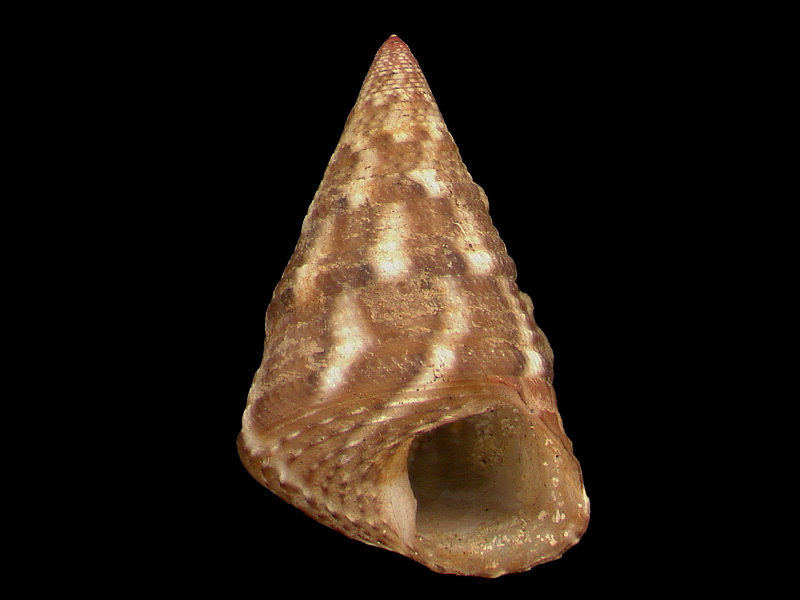Grooved top shell (Jujubinus striatus)
Distribution data supplied by the Ocean Biodiversity Information System (OBIS). To interrogate UK data visit the NBN Atlas.Map Help
| Researched by | Anna Neish | Refereed by | Admin |
| Authority | (Linnaeus, 1758) | ||
| Other common names | - | Synonyms | Cantharidus striatus , Trochus striatus (Linnaeus, 1758) |
Summary
Description
Recorded distribution in Britain and Ireland
Locally abundant in the Channel Islands but rare on the British and Irish coasts. There are records from south Devon, the Isle of Man and the Isles of Scilly, but recent records only from Bognor Regis, Falmouth, and Bryher in the Isles of Scilly.Global distribution
Distributed from the Mediterranean northward to south-west Britain.Habitat
At low water spring tides down to 300 m. Usually found around plants and seaweed especially Zostera marina, and on stones among Ulva and Codium species.Depth range
-Identifying features
- A pyramidal shaped top shell up to 10 mm high and 8 mm broad.
- Shell consists of 6 whorls, the last whorl relatively large.
- 8-10 smooth concentric ridges between keel and adapical suture on the last whorl and 7-9 ridges on its base.
- Relatively large, obliquely oval aperture, usually pink.
- Variable shell colour but usually brown and cream which can form alternating bands or a chequered pattern.
- Apical region of shell can be a carmine red colour.
- Umbilicus closed in adults.
- The foot has 3 pairs of epipodial tentacles.
Additional information
Jujubinus striatus is very similar to Jujubinus exasperatus which is one of three other species of Jujubinus recorded in Britain although none is common. Jujubinus striatus has apparently disappeared from many sites where it was formally common as there are no recent records.Listed by
- none -
Bibliography
Bruce, J.R., Colman, J.S. & Jones, N.S., 1963. Marine fauna of the Isle of Man. Liverpool: Liverpool University Press.
Graham, A., 1988. Molluscs: prosobranchs and pyramellid gastropods (2nd ed.). Leiden: E.J. Brill/Dr W. Backhuys. [Synopses of the British Fauna No. 2]
Hayward, P., Nelson-Smith, T. & Shields, C. 1996. Collins pocket guide. Sea shore of Britain and northern Europe. London: HarperCollins.
Hayward, P.J. & Ryland, J.S. (ed.) 1995b. Handbook of the marine fauna of North-West Europe. Oxford: Oxford University Press.
Howson, C.M. & Picton, B.E., 1997. The species directory of the marine fauna and flora of the British Isles and surrounding seas. Belfast: Ulster Museum. [Ulster Museum publication, no. 276.]
MBA (Marine Biological Association), 1957. Plymouth Marine Fauna. Plymouth: Marine Biological Association of the United Kingdom.
Seaward, D.R., 1990. Distribution of marine molluscs of north west Europe. Peterborough: Nature Conservancy Council.
Turk, S.M. & Seaward, D.R., 1997. The marine fauna and flora of the Isles of Scilly - Mollusca. Journal of Natural History, 31, 55-633.
Datasets
Conchological Society of Great Britain & Ireland, 2018. Mollusc (marine) data for Great Britain and Ireland - restricted access. Occurrence dataset: https://doi.org/10.15468/4bsawx accessed via GBIF.org on 2018-09-25.
Conchological Society of Great Britain & Ireland, 2018. Mollusc (marine) records for Great Britain and Ireland. Occurrence dataset: https://doi.org/10.15468/aurwcz accessed via GBIF.org on 2018-09-25.
NBN (National Biodiversity Network) Atlas. Available from: https://www.nbnatlas.org.
OBIS (Ocean Biodiversity Information System), 2024. Global map of species distribution using gridded data. Available from: Ocean Biogeographic Information System. www.iobis.org. Accessed: 2024-04-23
Citation
This review can be cited as:
Last Updated: 17/10/2005



